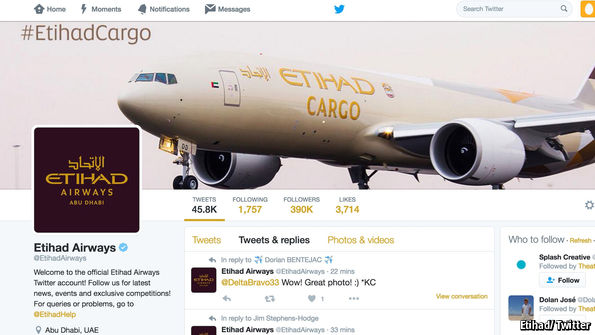Franchising, retail, business

18/03/2016
ON TUESDAY, Kyle Blaine, an editor at BuzzFeed, tweeted a recent Gulliver story on the “basic economy” sub-class being introduced by America’s leading airlines. These new fares will be “Reserved exclusively for those who tweet at airlines when having travel problems,” he wrote. Andrew Beaujon, an editor at Washingtonian magazine, replied, “No. 1 reason to unfollow someone.”
Repeated tweets about lousy airline service, it seems, may spur your friends to remove you from their feeds. The airlines themselves, though, are more forgiving. As frustrated flyers increasingly take to Twitter to vent their outrage, carriers are responding with helpful information or perks.
For both passenger and airline, a Twitter conversation can make more sense than a phone call. There is no time spent on hold, and the carrier's response can be both quick and measured. But the effectiveness of a social-media missive depends on the airline to which it is directed. If you want a rapid response, fly on JetBlue or Etihad Airways. If you are just seeking some empathy, you are better off on easyJet.
A study by Stratos Jet Charters, an Orlando-based air charter firm, analysed 1.3m tweets sent to airlines during the holiday season, between November 20th and January 9th (see table). It found that the quickest airline to respond to tweets is Volaris, a Mexican budget carrier, followed by JetBlue and Etihad.
Tweeting is not always an effective way to get a business’s attention. A report by Socialbakers, a social-media research firm, found that four out of five American companies ignore Twitter inquiries from customers. But airlines are more aware of the constant bad publicity generated by tweets complaining of bad service. Stratos notes that Volaris, an operation which is particularly conscious about social media, has two dedicated social-media support teams. JetBlue is also unusually devoted to Twitter responses, sometimes even tracking passengers down in person to follow up on virtual exchanges.
Many airlines outside Stratos's top five have also made a priority of Twitter. Mark Krolic, United Airlines’ managing director of marketing, told the Chicago Tribune last year, “While we monitor multiple social media channels to assist customers in our operation, Twitter is the one that we have the most robust services around.” Mr Krolic said that United had about two dozen employees devoted to social media. But not all airlines have latched onto this trend. Spirit Airways, a bare-bones operator, uses a robot to respond to customer tweets. Perhaps it is no coincidence that it is the most reviled airline among Twitter users.
According to the Stratos study, Jetstar, an Australian budget airline, is the likeliest to send empathetic tweets, containing language of apology or sympathy. EasyJet and Virgin America come in second and third place. The most common term used in passengers’ tweets at airlines is “thank you”. But don’t mistake it for gratitude; it is often used sarcastically. Other common terms include “delayed”, “cancelled”, “lost”, and, of course, a few blunt Anglo-Saxon adjectives.
Which brings us to a final word of advice for passengers seeking perks or answers over Twitter: don’t be excessively confrontational, and don’t be dumb. In the past couple of years, stories have proliferated of passengers being denied boarding or removed from flights for tweets they posted. A man was kicked off a Southwest flight after tweeting about a “rude” gate agent. A woman claimed she was booted from a JetBlue plane after she sent a tweet that was misinterpreted as an accusation that the pilot had been drinking. United removed a passenger who joked on Twitter that he could hack the plane’s controls and deploy the oxygen masks. The list goes on. Best not to join it.
Fonte:http://www.economist.com/blogs/gulliver/2016/03/reading-you-loud-and-clear?fsrc=gp_en?fsrc=scn/li/te/bl/ed/readingyouloudandclearsomeairlinestakecustomerstweetsmoreseriouslythanothers